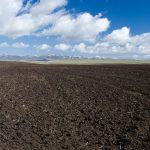If the climate reaches 2 degrees warming, nearly 230 billion tonnes of CO2 stored across the world’s soils – particularly, 1-metre topsoils – could be released into the atmosphere.
Along with the ocean and forests, the planet’s soils are one of the planet’s main “carbon sinks”. Through various biological mechanisms, they store and emit large amounts of carbon every year, for thousands of years.
Soils, in particular, contain very large amounts of carbon: about 2 to 3 times more than the amount of carbon present in the atmosphere. The mechanisms that allow soils to store carbon rely on the amount of plant life in the soil, its microbial activity, or even temperature parameters.
By modifying these variables, global warming has the power to affect the soil’s ability to store carbon. It can actually lead soils to contribute to increasing the amount of CO2 released and concentrated in the atmosphere.
Global Warming Decreases Soil Carbon Storage Capacity
The widespread adoption of industrial-intensive and monoculture farming practices has been eroding and depleting the world’s soils, putting food security in the medium-term at risk. But that’s not all: a study published in November 2020 in the journal Nature sheds an interesting (and worrying) light on the link between global warming and carbon sinks in soils.
The study’s researchers concluded that as global temperatures rise, soils are likely to store less and less carbon. In fact, nearly 230 billion tonnes of CO2 equivalents could even be released into the atmosphere, accelerated by surface permafrost melting.
To get to this conclusion, the scientists studied how temperature affects the carbon cycle in soils in various regions of the planet. They then used complex ecosystem models (Earth System Models) to understand how the expected evolution of temperatures caused by global warming would affect the global carbon cycle.
The results of these models lead them to the conclusion that if the planet reaches 2 degrees of global warming, the world’s soils could release between 220 and 270 billion tons of CO2 into the atmosphere.
Soil, Climate and Positive Temperature-Carbon Feedback Loops
In other words, in a warmer climate, soils will be a less efficient carbon sink: storing less CO2 and even releasing some of the previously stored carbon. In this case, at 2 degrees of temperature increase, these additional emissions could represent the equivalent of more than 5 years of global CO2 emissions. Or twice as much CO2 as the United States has emitted for nearly 100 years.
This means global warming could feed itself by increasing the amount of CO2 in the atmosphere. This is called a positive feedback loop. These feedback loops are particularly important phenomena, which highlight the complexity of global warming.
Because of these types of effects, global warming could well take off. Hence the importance of quickly limiting our CO2 emissions to avoid reaching critical thresholds where phenomena such as this one could feed into each other.
Soils: a Fundamental Issue in the Fight Against Global Warming
In this study, however, the researchers focused on the carbon stored in the surface layer of the soil, at a depth of up to one meter.
So there is “good” reason to believe that increasing temperatures could actually further degrade carbon cycles in soils, especially in deeper layers.
This study once again highlights the importance of ecological soil management in the fight against global warming. Whether we are talking about agriculture techniques, soil artificialisation, or ecological restoration, we see that it is fundamental to have a global (and urgent) approach to soil management. It holds one of the keys in the fight for climate preservation – and for our collective future.
- Related: Sustainability and Environmental Protection: 3 Documentaries From Mid 2020 You Shouldn’t Miss
[Photo by Zbynek Burival on Unsplash]

